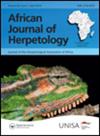濒临灭绝:雌性变色龙(Bradypodion pumilum)将自己的位置设置为尽量减少发现,而雄性则最大限度地增加交配机会
IF 0.9
4区 生物学
Q3 ZOOLOGY
引用次数: 3
摘要
摘要尽管变色龙的繁殖策略记录不多,但在一些物种中,精子储存已得到证实,通过增加受精的雌性数量和/或防止随后雌性与竞争雄性交配,可以最大限度地提高雄性繁殖成功率。寻找配偶等行为可能使雄性能够最大限度地增加与不同伴侣的交配机会,而保护配偶可能会增加雄性与特定雌性交配的可能性。在这项研究中,我们调查了矮角变色龙(Bradypodion pumilum)在运动(旅行距离)和栖息位置选择方面的性别行为差异,为更好地了解择偶和护偶行为提供了数据。野生变色龙在2010年被无线电跟踪(n = 8) 和2014(n= 5) 持续约两周。每天多次记录地理位置和栖息高度,以捕捉迁徙的规模和栖息的用途。使用线性混合效应模型来评估性别之间的差异。我们的研究结果表明,雌性比雄性栖息得更低,移动的距离更短,这为雄性的择偶策略提供了支持。特别的实地观察显示,一些雄性的行为与保护配偶一致,而一些不易接受的雌性则与回避配偶一致。我们的研究结果可能表明,雄性通过在保护配偶和寻找配偶的环境中使用更高的栖息位置,以及在寻找可接受的雌性时移动更远的距离,来提高它们的繁殖适应性。本文章由计算机程序翻译,如有差异,请以英文原文为准。
Out on a limb: female chameleons (Bradypodion pumilum) position themselves to minimise detection, whereas males maximise mating opportunity
ABSTRACT Although reproductive strategies are poorly documented in chameleons, sperm storage has been confirmed among some species for which male reproductive success may be maximised by increasing the number of females inseminated and/or preventing subsequent female copulation with rival males. Behaviour, such as mate searching, may enable males to maximise the number of mating opportunities with different partners and mate guarding may increase the likelihood that a male will sire offspring with a particular female. In this study, we investigated behavioural differences in movement (distance travelled) and perch choice between sexes of the Cape Dwarf Chameleon, Bradypodion pumilum, to offer data for a better understanding of mate searching and mate guarding behaviours. Wild chameleons were radio-tracked in 2010 (n = 8) and 2014 (n = 5) for approximately two weeks. The geographic location and perch height above ground were recorded multiple times per day to capture both the scale of movement and their perch use. Linear mixed effect models were used to assess differences between sexes. Our results indicated that females perched lower than males and moved shorter distances, offering support of a mate searching strategy in males. Ad hoc field observations revealed behaviours consistent with mate guarding by some males, and mate avoidance by some unreceptive females. Our results could indicate that males increase their reproductive fitness by using higher perches in both a mate guarding and mate searching context and moving further distances in search of receptive females.
求助全文
通过发布文献求助,成功后即可免费获取论文全文。
去求助
来源期刊

African Journal of Herpetology
ZOOLOGY-
CiteScore
3.00
自引率
6.70%
发文量
15
审稿时长
>12 weeks
期刊介绍:
African Journal of Herpetology (AJH) serves as an outlet for original research on the biology of African amphibians and reptiles. AJH is an interdisciplinary journal that publishes original articles and reviews from diverse fields and disciplines, such as conservation, phylogenetics, evolution, systematics, performance, physiology, ecology, behavioural ecology, ethology, and morphology.
The Journal publishes two issues a year. There are no page charges .
 求助内容:
求助内容: 应助结果提醒方式:
应助结果提醒方式:


